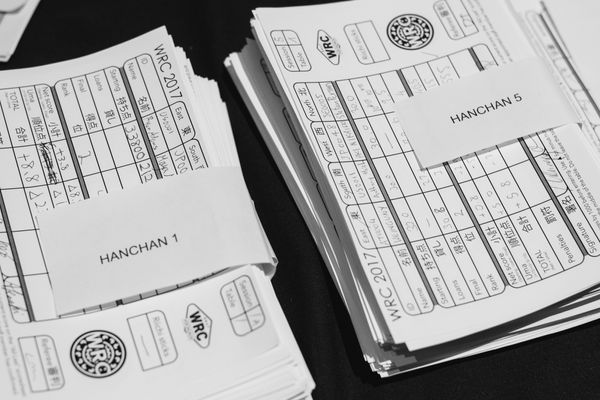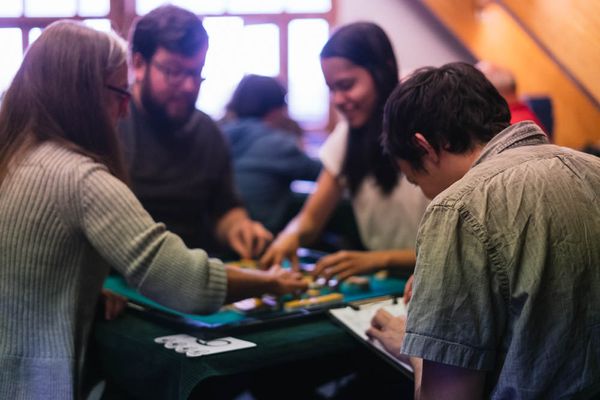Berries and Boss Fights in Bad Vöslau

If you’re a follower of our humble blog, you’d know that the Osamuko community has a solid and active European contingent, who frequently get together on the EMA tournament circuit. Indeed we’ve collected a rather respectable array of tournament wins and rankings, that I’ve often thought it would be nice, if a little show-offish, to have a page celebrating all the accomplishments and loot we’ve hauled back from our conquests. Earlier this week our motley crew headed to picturesque Austria to show them some of our own architecture, the magnificent pon palaces and chi castles that litter the little Tenhou lobby we call our own.
As expected, the journey was not without incident. Not long after setting off, our protagonist Sir Osamu himself ran into a bit of bother along the way. Through some unfortunate circumstances he found himself stranded in the middle of nowhere with no money, accommodation, food or transport. However such is the brotherhood of fellow mahjong players that a few phone calls were enough to secure everything he needed. We would like to express our heartfelt gratitude to those honorable gentlemen who graciously helped him out in his distress, or we would have no one to renew the domain. Those of us who didn’t attend the tournament had to content ourselves with following the progress of our friends through coverage provided by the esteemed mahjongnews.com. However what caught my eye was not the coverage but this rather interesting piece.
At first glance, it seems amusingly ironic how the person who has benefited the most from poor players to rise to the top of the EMA rankings is complaining about the same. Well, I’m a bad player, and I’ve spent all my days playing bad players. Let me tell you about bad players. When we deal into a hand, we do not concern ourselves with which hand we are dealing in. We just want to get rid of our useless tiles. Even though it seems like we favour particular players, allow me to assure you that is not the case. We believe in equal opportunities, and all you need to do is seize that opportunity to chalk up another win. Mr C. has doubtless enjoyed a great amount of questionable deal-ins in the past, and the law of averages was bound to catch up with him sooner or later. Or does he attribute his wins to skill and his losses to bad luck?
Subsequently there’s a lament for the “riichi style” of play, whatever that means. Supposedly it loses to pon palace and calling like crazy? If so, who would want to adopt a losing style? Over all the games of riichi mahjong I’ve played, if there’s one common theme in winning playstyles, it’s being able to read the situation. I can but speculate that the increase in calling was prompted by the disallowing of kuitan (open Tan Yao). Do you know what calling does to your hand? To put it in a nutshell, it decreases randomness and increases the speed of your hand. Instead of drawing a random tile, you give up potential score and safety to pick up a known tile. Kuitan allows you to turn almost any hand into a fast hand. Disallowing kuitan shoots the random luck factor through the roof, as the importance of your opening hand is emphasized heavily – you either have something, or you’d better start calling tiles early on if you want even a small chance at making a hand, any hand. Were I in attendance, I wouldn’t be shy at all to call aggressively under such rules. Ironically enough, what the EMA presumably fears is an endless onslaught of kuitan hands if it is ever allowed in tournament play, which is – surprise, surprise – countered by their vaunted traditional riichi playstyle. Calling twice and watching someone riichi will put you between the proverbial rock and hard place, forcing you to risk a large hit for minimal value, or give up a fast hand to form a shaky defense.
However, that’s not the most surprising of his declarations yet. He even advocates that players preferably be grouped by country. Now I am an online player through and through. I see no reason whatsoever to leave my comfy chair and venture into the outside world, to find three other people of varying skill to play mahjong with. Fiddling with counting scores and building walls and rolling dice? No sir, not for me, thank you very much. And yet it’s a trend that’s getting more popular – even as our little community grows, people very much want to meet up and face each other across real live tiles. And I know why.
I have often thought it somewhat a paradox, that people play riichi mahjong together, yet everyone ultimately plays alone. Online, it’s a given to view your opponents as a non-entity, an artificial or even alien intelligence. It’s hard to care about the perspective of Aさん or Bさん when thinking about one’s own hand and score situation. Indeed, it’s easier to group them all together into a single three-headed mega-opponent, and so every game becomes a boss fight. Playing together in real life breaks down these barriers. The opponent on your left wears glasses and sniffs a little whenever he draws a good tile, the one on your right looks a little sleepy and has hairy ears. You can’t deny their humanity when they’re sitting in front of you. When I’m playing against people I know, I feel more sympathetic towards their ingame situation, and when I trust their skill, I know that had I been in their seat, I could easily have suffered the same adverse fate. Being able to interact with your opponents truly enhances the experience, even if you have nothing to say at all. It is because of this that we have been growing our community and expending effort towards maintaining online leagues. Even as I write this, I can see four players good-naturedly chaffing each other on IRC while playing, and I would include some of the chat if it weren’t so… unpublishable. More so than in other games, community in mahjong is important, if only to dispel the looming impression that you’re playing against a three-handed monster who wins 75% of the time. Respect your opponents and see them as human, and you’ll already have cut their winrates down to 25% each. It is this mutual respect and friendship between players that the EMA should work on cultivating.
In conclusion I would advise Mr C. to be happy that he was fortunate enough to meet less-skilled opponents. Good players should always be happy to play bad players, unless they have some bizarro playstyle that only works against good players. If he is frustrated it is because he failed to see them as fellow mahjong enthusiasts but as an annoying combined boss fight that he was unable to coast through. Perhaps in aid of this, the liquor contributed by various participants should be shared before, rather than after the games.
Stay tuned and find out if I can bully some people into writing trip reports.
The photo above is a bunch of berries Osamu found while lost in the wilderness and was considering eating. We still do not know whether they are safe for human consumption. In case you run into a similar situation in the future, he recommends you start your own mahjong blog.



